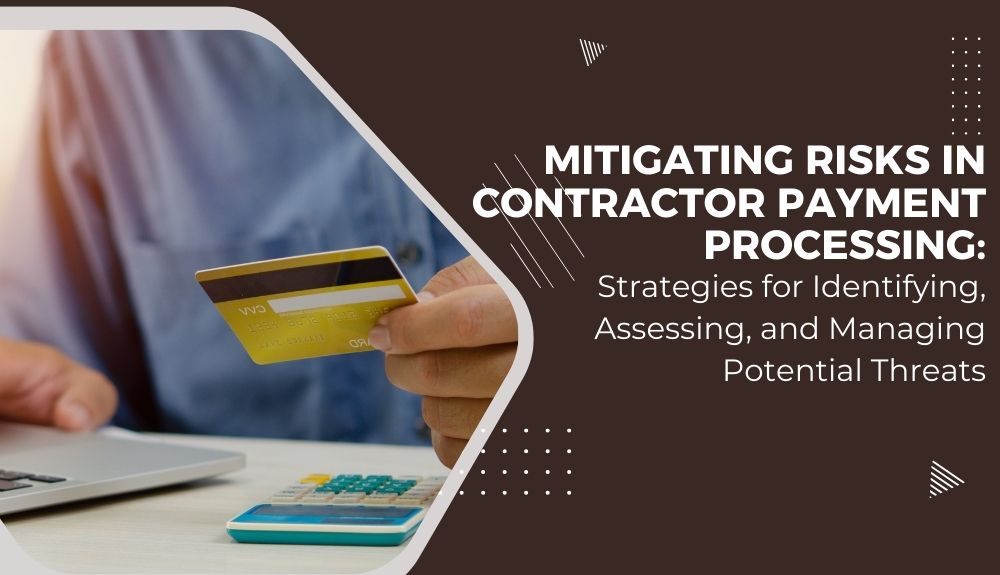
By alphacardprocess March 20, 2024
Welcome to the world of contractor payment processing, where efficiency meets complexity. As businesses increasingly rely on external contractors for specialized services, ensuring seamless payment processes becomes crucial. However, with great convenience comes great responsibility. Let’s delve into the realm of mitigating risks in contractor payment processing and discover strategies to safeguard your financial transactions.
Potential Risks in Contractor Payment Processing
When it comes to contractor payment processing, there are various potential risks that businesses need to be aware of. One significant risk is the possibility of fraudulent activities, where contractors may submit false invoices or overcharge for services rendered. This can result in financial losses and damage to the business’s reputation.
Another risk to consider is non-compliance with regulations and laws governing contractor payments. Failure to adhere to legal requirements can lead to penalties, lawsuits, and other legal consequences. Additionally, issues such as late payments or discrepancies in billing can strain relationships with contractors and impact future collaborations.
Data security is also a crucial concern in contractor payment processing. With sensitive information being exchanged during transactions, there is a risk of data breaches that could compromise confidential data. It’s essential for businesses to have robust security measures in place to protect against cyber threats and safeguard sensitive financial information.
Identifying and Assessing Risks

When it comes to contractor payment processing, identifying and assessing risks is crucial for ensuring smooth operations. By recognizing potential threats early on, businesses can proactively mitigate any negative impacts on their financial transactions.
One key aspect of identifying risks is conducting a thorough evaluation of the payment process from start to finish. This includes analyzing each step involved in paying contractors, such as verifying invoices, approving payments, and transferring funds.
Additionally, businesses should assess external factors that could pose risks to contractor payments, such as changes in regulations or cybersecurity threats. By staying informed about industry trends and potential challenges, organizations can better anticipate and address any issues that may arise.
Moreover, implementing robust monitoring mechanisms can help detect anomalies or suspicious activities in contractor payment processing. Regularly reviewing transaction logs and conducting audits are effective ways to stay vigilant against fraudulent behavior.
A proactive approach to identifying and assessing risks in contractor payment processing is essential for safeguarding financial assets and maintaining trust with contractors.
Strategies for Managing Risks
When it comes to managing risks in contractor payment processing, having effective strategies in place is crucial. One key strategy is to establish clear communication channels between all parties involved. This can help identify and address any potential issues before they escalate.
Another important approach is to conduct regular audits and reviews of payment processes to ensure compliance with regulations and industry standards. By staying proactive, businesses can mitigate the risk of fraud or errors.
Implementing robust security measures, such as encryption protocols and multi-factor authentication, can also help safeguard sensitive payment information from cyber threats. Additionally, utilizing secure payment platforms with built-in fraud detection capabilities can provide an extra layer of protection.
Moreover, developing contingency plans for unexpected disruptions in payment processing can minimize the impact on operations and finances. Being prepared for unforeseen circumstances is essential for maintaining business continuity.
A combination of proactive communication, thorough monitoring, enhanced security measures, and contingency planning are vital components of effective risk management in contractor payments processing.
Best Practices for Secure Contractor Payment Processing

When it comes to ensuring secure contractor payment processing, there are several best practices that businesses can implement to safeguard their financial transactions. Utilizing encrypted payment gateways can help protect sensitive data from potential cyber threats. Selecting reputable and trusted third-party payment processors is also crucial in maintaining the security of contractor payments.
Moreover, implementing multi-factor authentication for accessing payment systems adds an extra layer of protection against unauthorized access. Regularly monitoring transaction activities and promptly addressing any suspicious behavior can prevent fraudulent activities before they escalate. Providing contractors with detailed invoices and transparent payment terms fosters trust and reduces disputes over payments.
Conducting regular security audits and staying informed about the latest cybersecurity trends ensures that businesses stay ahead of potential risks in contractor payment processing. By following these best practices diligently, businesses can minimize vulnerabilities in their payment processes and maintain a secure financial environment for all parties involved.
Conclusion and Recommendations for Contractors and Businesses
Contractors and businesses must prioritize secure payment processing to mitigate potential risks effectively. By identifying, assessing, and managing these threats proactively, they can safeguard their financial transactions and reputations. Implementing best practices such as using secure payment platforms, conducting regular risk assessments, and monitoring transactions closely can help ensure a smooth contractor payment process. Remember that staying informed about the latest security measures is crucial in today’s digital landscape. By following these strategies and recommendations, contractors and businesses can enhance their overall payment processing security while maintaining trust with their stakeholders.